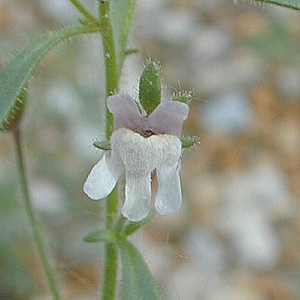
Roots:
Slender taproot. (1) 
Stems/Leaves: The stems are small and narrow which are covered in white hairs and they grow to about 30 cm tall. The leaves that are lower then the rest are opposite while the leaves in the middle to the upper ones are alternate. The leaves get up to 1 inch long and 1/6 of an inch across. (1,2)
Flowers: From the middle or upper leaves grows a flower developing from a slender pedicel about 1 inch long. Sometimes a second flower will show up on the stem also. Similar to the stems these flowers are covered in white hairs. The flower gets up to about 1/4 of an inch in length. The flower has five spreading lobes in the front and a short spur in the back. The corolla has a small opening at the throat. Here there is more or less two-lipped with two upper lobes and three lower lobes. The flower itself comes in a variety of colors. It comes in lavender, light purple, or white. The flower blooms in the summer and flowering lasts about a month. (1)
Fruits and Seeds: The seeds are made in a ovoid capsule that was once the flower, there are of brown seeds in the fruit. The seeds are so small they can be dispersed by gusts of wind. (1)
Reproduction: The plant reseeds itself by spreading the seeds by the wind. (1)
Life Style/Habits/Life duration: This plant likes to be in places that are dry and sunny with sterile soil that is sandy or gravely. It also likes to grow in places with a little less sun and more humid, with this it becomes taller and more leaves appear. In more fertile soil the plant is not competitive with taller vegetation in the area. It prefers to be in disturbed areas. This plant originally came from the Mediterranean area of Europe. (1)
Environments Favorable to Infestation: The plant likes to show up at places like gravely areas along railroads, sandy or gravely areas along roads, gravely borders along buildings, and sterile waste areas. (1)
Methods of Control: You
can do cultural with highly competitive
vegetation. Mowing is not the best way to go on this one,
pulling would be better. (3)
Biological Control: No know facts on this weed. (3)
Herbicides: No herbicides found.
1) http://www.illinoiswildflowers.info/weeds/plants/dw_snapdragon.htm
2) http://www.missouriplants.com/Blueopp/Chaenorrhinum_minus_page.html
3) http://www.wssa.net/photo&info/weedstoday_info/snapdragon.htm
4) http://plants.usda.gov/java/profile?symbol=CHMI
5) http://database.dotflowers.com/item-dwarf-snapdragon.html
6) http://www.co.stevens.wa.us/weedboard/other%20weeds/dwarfsnap.htm
7) http://www.omafra.gov.on.ca/english/crops/hort/news/hortmatt/2003/19hrt03a7.htm
8) http://www.usgs.nau.edu/SWEPIC/aspDB/unified.asp?Symbol=CHMI
9) http://www.dijon.inra.fr/hyppa/hyppa-a/chnmi_ah.htm
10)
http://shoshoneweeds.com/plan.html